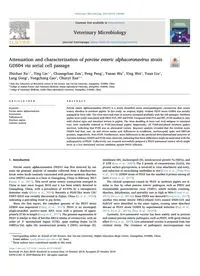
2019 Attenuation and characterization of porcine enteric alphacoronavirus strain GDS04 via serial cell passage PDF
Preview 2019 Attenuation and characterization of porcine enteric alphacoronavirus strain GDS04 via serial cell passage
Contents lists available at ScienceDirect Veterinary Microbiology journal homepage: www.elsevier.com/locate/vetmic Attenuation and characterization of porcine enteric alphacoronavirus strain GDS04 via serial cell passage Zhichao Xua,1, Ying Lina,1, Chuangchao Zoua, Peng Penga, Yanan Wub, Ying Weia, Yuan Liua, Lang Gongc, Yongchang Caoa, Chunyi Xuea,* a State Key Laboratory of Biocontrol, School of Life Science, Sun Yat-sen University, Guangzhou, 510006, China b College of Animal Science and Veterinary Medicine, Henan Agricultural University, Zhengzhou, 450046, China c College of Veterinary Medicine, South China Agricultural University, Guangzhou, 510642, China A R T I C L E I N F O Keywords: Porcine enteric alphacoronavirus Attenuation Pathogenicity Newborn piglets Genomic analysis A B S T R A C T Porcine enteric alphacoronavirus (PEAV) is a newly identified swine enteropathogenic coronavirus that causes watery diarrhea in newborn piglets. In this study, an original, highly virulent PEAV strain GDS04 was serially passaged in Vero cells. The virus titers and sizes of syncytia increased gradually with the cell passages. Newborn piglets were orally inoculated with PEAV P15, P67 and P100. Compared with P15 and P67, P100 resulted in only mild clinical signs and intestinal lesions in piglets. The virus shedding in feces and viral antigens in intestinal tract were markedly reduced in P100-inoculated piglets. Importantly, all P100-inoculated newborn piglets survived, indicating that P100 was an attenuated variant. Sequence analysis revealed that the virulent strain GDS04 had four, one, six and eleven amino acid differences in membrane, nucleocapsid, spike and ORF1ab proteins, respectively, from P100. Furthermore, more differences in the predicted three-dimensional structure of S protein between GDS04 and P100 were observed, indicating that these differences might be associated with the pathogenicity of PEAV. Collectively, our research successfully prepared a PEAV attenuated variant which might serve as a live attenuated vaccine candidate against PEAV infection. 1. Introduction Porcine enteric alphacoronavirus (PEAV) was first detected by our team via genomic analysis of samples collected from a diarrhea-out- break swine herds routinely vaccinated with porcine epidemic diarrhea virus (PEDV) vaccine in a farm in Guangdong, China in February 2017 (Gong et al., 2017). This novel swine enteric coronavirus emerged in China at least since August 2016 and it has been widely detected in Guangdong, China, with a prevalence of 43.53% by a retrospective detection study (Zhou et al., 2019). Recently a PEAV-like strain CN/ FJWT/2018 was recently discovered in Fujian, China (Li et al., 2018), indicating a prevailing trend in pig farms. Since the first report, the complete genome of the PEAV strain GDS04 was sequenced (Gong et al., 2017). PEAV is an enveloped, single-stranded, positive-sense RNA virus with a genome of appro- priately 27 kb in length (Gong et al., 2017). The genome organization of PEAV is similar to that of bat-like HKU2 strains of coronavirus, with an order of: 5′ untranslated region (UTR), open reading frame 1a/1b (ORF1a/1b), spike (S), nonstructural protein 3 (NS3), envelope (E), membrane (M), nucleocapsid (N), nonstructural protein 7a (NS7a), and 3′ UTR (Lau et al., 2007). The S protein of coronaviruses (CoVs), the pivotal surface glycoprotein, is involved in virus attachment and entry, and induction of neutralizing antibodies in vivo (Cruz et al., 2008; Woo et al., 2010). GDS04 strain of PEAV has the smallest S protein among all CoVs (Gong et al., 2017). The clinical symptoms caused by PEAV in newborn piglets are si- milar to that by other porcine enteric pathogens such as PEDV and transmissible gastroenteritis virus (TGEV), which include vomiting, diarrhea, dehydration, and mortality rate as high as 90% (Gong et al., 2017; Zhou et al., 2018b). Since PEAV was detected (Gong et al., 2017), another two swine enteric HKU2-related CoVs named SADS-CoV and SeACoV were identified in the same region, causing same diarrheal disease as PEAV strain GDS04 by experimental infection (Pan et al., 2017; Xu et al., 2019a; Zhou et al., 2018b). Currently, live-attenuated vaccine has been widely used to prevent and control porcine enteric pathogens, such as PEDV, with good clinical effect (Song et al., 2007). Live-attenuated vaccine is prepared from less virulent strain. The virulence of pathogenic microorganisms was https://doi.org/10.1016/j.vetmic.2019.108489 Received 19 June 2019; Received in revised form 14 October 2019; Accepted 27 October 2019 ⁎ Corresponding author at: School of Life Science, Sun Yat-sen University, Higher Education Mega Center, Guangzhou, 510006, China. E-mail address:
